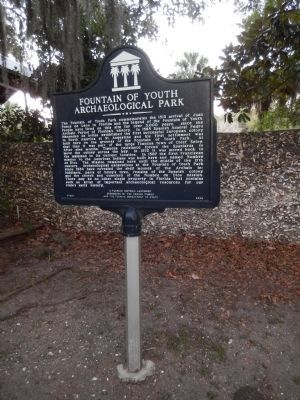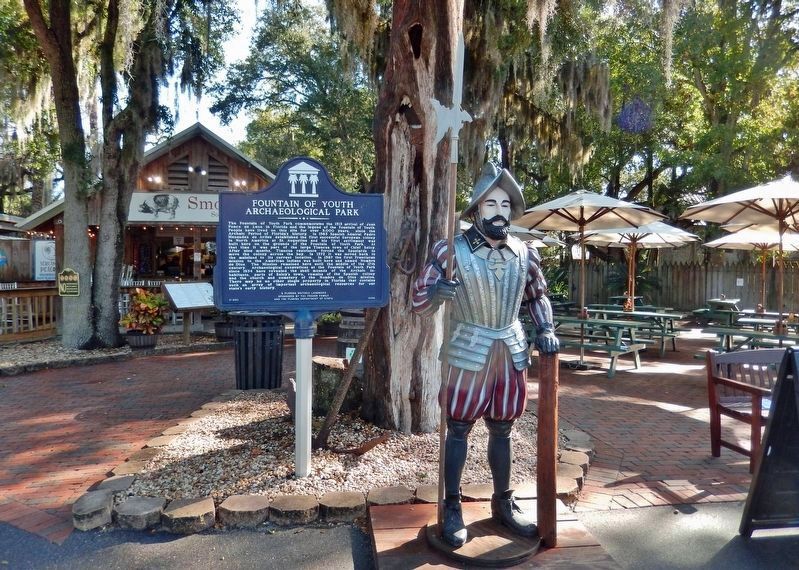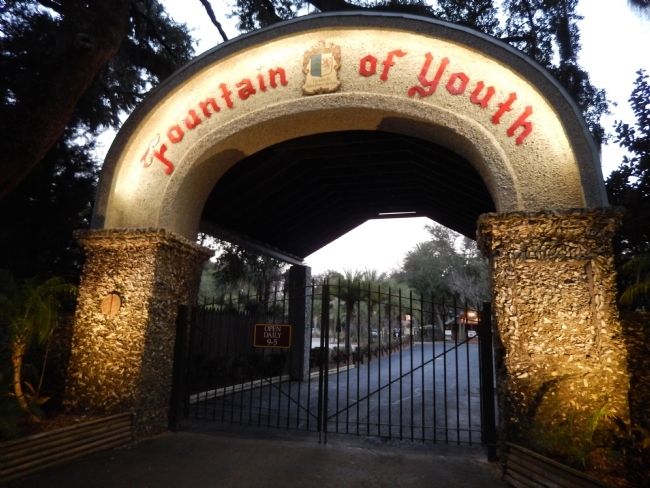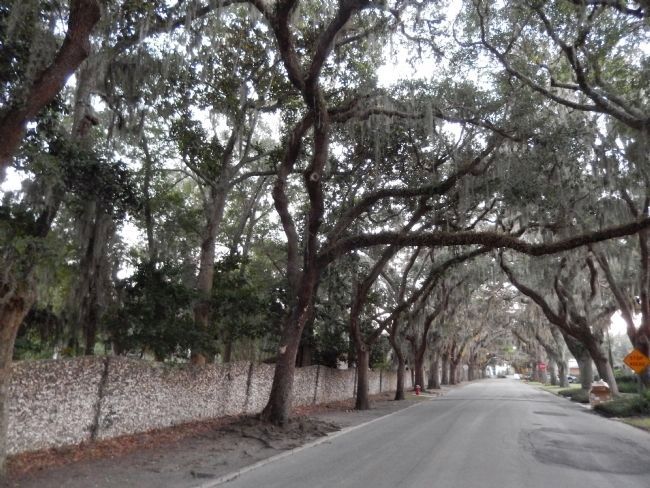Historic District in St. Augustine in St. Johns County, Florida — The American South (South Atlantic)
Fountain of Youth Archaeological Park
The Fountain of Youth Park commemorates the 1513 arrival of Juan Ponce de Leon in Florida and the legend of the Fountain of Youth. People have lived on this site for over 3,000 years, since the Archaic Period of Florida’s history. In 1565 Spanish Admiral Pedro Menendez de Aviles established the first successful European colony in North America at St. Augustine and his first settlement was built here on the grounds of the Fountain of Youth Park. At that time it was part of the large Timucua town of Chief Seloy. After nine months, Timucua resistance forced the Spaniards to move the colony across the bay. In 1572 it was moved back to the mainland to its current location. In 1587 the first Franciscan mission to the American Indians was built here and named Nombre de Dios. The Mission remained here until the middle of the 17th century. Archaeological excavations at the fountain of Youth Park since 1934 have revealed the shell mounds of the Archaic inhabitants, parts of Seloy’s town, remains of the Spanish colony and the church and cemetery of the Nombre de Dios mission. There may be no other single property in Florida that contains such an array of important archaeological resources for our state’s early history.
Erected 2008 by A Florida Historic Landmark sponsored by the Fraser family and the Florida Department of State. (Marker Number F-637.)
Topics. This historical marker is listed in these topic lists: Colonial Era • Exploration • Native Americans • Settlements & Settlers. A significant historical year for this entry is 1513.
Location. 29° 54.449′ N, 81° 18.981′ W. Marker is in St. Augustine, Florida, in St. Johns County. It is in the Historic District. Marker is at the intersection of Magnolia Avenue and Williams Street, on the left on Magnolia Avenue. Marker is located at the main entrance to Fountain of Youth Archaeological Park, on the south side of the gate. Touch for map. Marker is at or near this postal address: 11 Magnolia Avenue, Saint Augustine FL 32084, United States of America. Touch for directions.
Other nearby markers. At least 8 other markers are within walking distance of this marker. First Spanish Muster Site in Florida (here, next to this marker); Pedro Menéndez de Aviles (within shouting distance of this marker); U.S.S. Constitution Cannons (about 300 feet away, measured in a direct line); Common Anchor (about 300 feet away); Tinajónes (about 300 feet away); Copper Cauldron (about 400 feet away); Tabby / Coquina (about 400 feet away); 1565 Menendez (about 400 feet away). Touch for a list and map of all markers in St. Augustine.
More about this marker. There are two identical copies of this marker. One is located outside the front
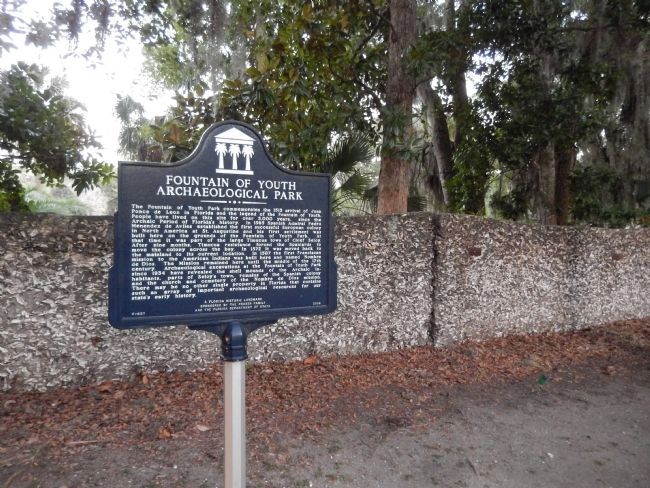
Photographed By Cosmos Mariner, December 10, 2014
2. Fountain of Youth Archaeological Park Marker
Park boundary fence behind marker illustrates local tabby concrete construction. Tabby is a type of concrete made in the seventeenth century, by burning oyster shells to create lime, then mixing it with a slurry of water, local sand and broken oyster shells.
Related markers. Click here for a list of markers that are related to this marker. Ponce de León's Fountain of Youth Archaeological Park
Also see . . .
1. The Fountain of Youth - St. Augustine, Florida.
It is here on the waterfront of the 15-acre park that one of the most significant historic sites in America can be found. In a grassy area overlooking the marshes, archaeologists have discovered the buried remains of the original fort and settlement of St. Augustine. (Submitted on December 10, 2014, by Cosmos Mariner of Cape Canaveral, Florida.)
2. The Original 1565 Site of St. Augustine.
The original site of the nation's oldest city. Located in the area first explored by Juan Ponce de León in 1513 and settled by Pedro Menéndez de Avilés in 1565, historic St. Augustine is the oldest successful European settlement in the United States. Colonial America started right HERE, 55 years before the Pilgrims landed on Plymouth Rock, and 42 years before Jamestown! (Submitted on December 10, 2014, by Cosmos Mariner of Cape Canaveral, Florida.)
3. Pedro Menéndez de Avilés.
Spanish seaman, founder of St. Augustine, Florida, was born at Avilés in Asturias on the 15th of February 1519. (Submitted on December 10, 2014, by Cosmos Mariner of Cape Canaveral, Florida.)
Credits. This page was last revised on December 29, 2021. It was originally submitted on December 10, 2014, by Cosmos Mariner of Cape Canaveral, Florida. This page has been viewed 978 times since then and 50 times this year. Photos: 1, 2, 3. submitted on December 10, 2014, by Cosmos Mariner of Cape Canaveral, Florida. 4. submitted on December 27, 2021, by Cosmos Mariner of Cape Canaveral, Florida. 5, 6. submitted on December 10, 2014, by Cosmos Mariner of Cape Canaveral, Florida. • Bill Pfingsten was the editor who published this page.

